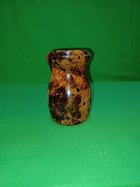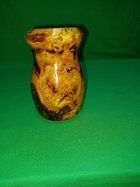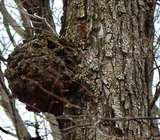I have a couple cherry galls here and I'm wondering how they might turn? Anyone have any experience with them? Are they mostly hollow or similar to burls inside? Thanks
-
We just finished moving the forums to a new hosting server. It looks like everything is functioning correctly but if you find a problem please report it in the Forum Technical Support Forum (click here) or email us at forum_moderator AT aawforum.org. Thanks! -
Beware of Counterfeit Woodturning Tools (click here for details) -
Johnathan Silwones is starting a new AAW chapter, Southern Alleghenies Woodturners, in Johnstown, PA. (click here for details) -
Congratulations to Dave Roberts for "2 Hats" being selected as Turning of the Week for April 22, 2024 (click here for details) -
Welcome new registering member. Your username must be your real First and Last name (for example: John Doe). "Screen names" and "handles" are not allowed and your registration will be deleted if you don't use your real name. Also, do not use all caps nor all lower case.
You are using an out of date browser. It may not display this or other websites correctly.
You should upgrade or use an alternative browser.
You should upgrade or use an alternative browser.
Wood turning Cherry Galls?
- Thread starter Denny Nebgen
- Start date
Only had a few of them, had more oak galls. They had far more voids in them than burl. The oak ones reminded me of lava flows, kind of layered rather than bulging out from a center point. Put one on the lathe and turn it. Stand out of the line of fire!
robo hippy
robo hippy
Thank you sir, I appreciate the response.
I have opened some up and they are basically just an empty shell, the insect larva eats the inside to mature and then tunnels out, you'll find a very small hole in them when the larva left, anyway there is no solid inside.
There are different gall wasps and the galls are different, when the gall is still green you can find some soft material in there and a maybe a grub as well.
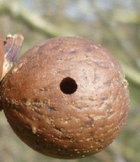
There are different gall wasps and the galls are different, when the gall is still green you can find some soft material in there and a maybe a grub as well.

Last edited:
That’s a very attractive turning. What you are calling a gall, I think may be a burl. When I hear gall, I picture what Leo has posted - a tree’s reaction to an insect. Maybe semantics. In any case, you’ve done a neat job of using it and filling voids with resin.
This has been discussed on a couple of woodturning sites where Denny has posted. One is a gall, and the other is caused by a gall wasp. Both can be called a gall. https://www.gardeningknowhow.com/edible/fruits/cherry/what-is-cherry-tree-gall.htmThat’s a very attractive turning. What you are calling a gall, I think may be a burl. When I hear gall, I picture what Leo has posted - a tree’s reaction to an insect. Maybe semantics. In any case, you’ve done a neat job of using it and filling voids with resin.
I stand corrected. Thanks for the education Richard!
I do not agree with the Gardeners idea of a burl calling it a Cherry gall, these growths have been called burls or burrs for a very long time, growing on any type of tree, be it Maple, Oak or Cherry.
The Cherry gall IMO is a gall on a leaf, could be an Oak leaf or other that will turn red like a cherry, that is a Cherry gall, as shown in these pictures.
The explanation of the galls is that it is caused by wasps and the plant grows these and other types depending the wasp species.
What the gardeners are referring to is a disease that affect better than 140 plants and is called Crown gall, (they do so to) quite a different animal, actual a bacterium and it does not form solid wood as in a Burl.
I got some info on that below if you are interested in this kind of stuff.
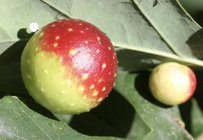
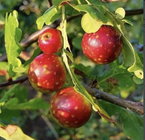
This is part of the gardeners explanation of the galls but it is not the wood burl growing on all kinds of trees, including Cherry trees,
it is a bacterial growth as seen on many plants including trees, it is called CROWN GALL, not CHERRY GALL.

Crown galls as seen on trees.
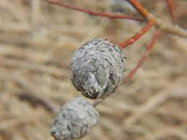
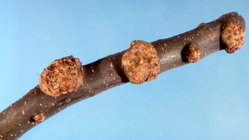
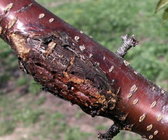
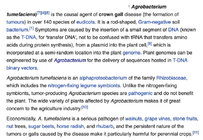
THERE is more if you like to know, just google KROWN GALL,
The Cherry gall IMO is a gall on a leaf, could be an Oak leaf or other that will turn red like a cherry, that is a Cherry gall, as shown in these pictures.
The explanation of the galls is that it is caused by wasps and the plant grows these and other types depending the wasp species.
What the gardeners are referring to is a disease that affect better than 140 plants and is called Crown gall, (they do so to) quite a different animal, actual a bacterium and it does not form solid wood as in a Burl.
I got some info on that below if you are interested in this kind of stuff.


This is part of the gardeners explanation of the galls but it is not the wood burl growing on all kinds of trees, including Cherry trees,
it is a bacterial growth as seen on many plants including trees, it is called CROWN GALL, not CHERRY GALL.

Crown galls as seen on trees.




THERE is more if you like to know, just google KROWN GALL,
Here is another picture of cancers and also called galls, these are on a Hickory tree, I've seen similar ones on other tree species also on wild Cherry shrubs and trees.I stand corrected. Thanks for the education Richard!
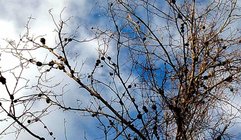
Here are two pictures, in the first picture they call it a Gall
in the second picture we call it a Burl
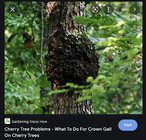
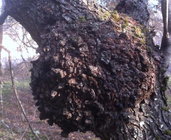
I think this has been enough of a correction on the Cherry Gall misnomer.
Last edited:
Well this is my first experience with using a gall and although they both had more voids inside than some burls, I found that much of the grain was very similar to a burl. I was told by a fellow in my wood turners group who is in his eighties that burls would be on the bottom of the tree and galls would be up higher on the stem. After having seen what the grain inside looks like on the two pieces I have turned, I think they are more similar to burls than I had expected.Although I am by no means an expert on this. I have only turned a few pieces of burl to date and the grain patterns are similar to these "galls" inside.
I stand further corrected! This semantic confusion really galls me!
Tom Gall
TOTW Team
Ahem!!!! ...... I'm getting a little tired of my name being bandied about on this thread!I stand further corrected! This semantic confusion really galls me!
Mr. Gall:
Nomen est omen!
Amen...
Nomen est omen!
Amen...
Maybe you misunderstood the old guy Denny, (I'm just starting my 80th year in May coming up) as yes a lot of the cancerous galls do grow on thin twigs and branches and these are of course higher up, where the burls grow on the tree trunk.Well this is my first experience with using a gall and although they both had more voids inside than some burls, I found that much of the grain was very similar to a burl. I was told by a fellow in my wood turners group who is in his eighties that burls would be on the bottom of the tree and galls would be up higher on the stem. After having seen what the grain inside looks like on the two pieces I have turned, I think they are more similar to burls than I had expected.Although I am by no means an expert on this. I have only turned a few pieces of burl to date and the grain patterns are similar to these "galls" inside.
Here's one that is growing on the trunk of a Maple at my son's place, though it is higher up on the trunk, but it is still a burl, (I would love to get my hands on it, but that will not happen I'm afraid
Attachments
I have seen examples of cherry galls and burls exactly as Leo has pictured on the naturally occurring black cherry trees in my area ( very close to lake Itasca the source of the Mississippi). The trees seldom get bigger then about 8" dimeter before they die of ring rot.Here is another picture of cancers and also called galls, these are on a Hickory tree, I've seen similar ones on other tree species also on wild Cherry shrubs and trees.
View attachment 42816
Here are two pictures, in the first picture they call it a Gall
in the second picture we call it a Burl
View attachment 42817
View attachment 42818
I think this has been enough of a correction on the Cherry Gall misnomer.
Do you have a photo of what it looked like before you turned or cut it?Well this is my first experience with using a gall and although they both had more voids inside than some burls, I found that much of the grain was very similar to a burl. I was told by a fellow in my wood turners group who is in his eighties that burls would be on the bottom of the tree and galls would be up higher on the stem. After having seen what the grain inside looks like on the two pieces I have turned, I think they are more similar to burls than I had expected.Although I am by no means an expert on this. I have only turned a few pieces of burl to date and the grain patterns are similar to these "galls" inside.
I do not. The tree stem was maybe two or three inches in diamete and the piece itself was about 6 or 7 inches in diameter, maybe even larger and that much in height completely all around the stem. Never thought of taking a photo of it. I guess I should have.
Was it similar to the picture that Leo posted that showed a burl like growth on the side of a black cherry trunk with extremely rough bark?I do not. The tree stem was maybe two or three inches in diamete and the piece itself was about 6 or 7 inches in diameter, maybe even larger and that much in height completely all around the stem. Never thought of taking a photo of it. I guess I should have.
Yes it was similar
I need to apologize. I talked to Duane again via email. It was not galls that he called the ones on the stem (I think I saw that on an article on the web). He called them "Plum Knot Virus" that are the ones on the stem. My bad. I mixed the two up. I guess it affects many trees including Cherry and Plums.
The two I have turned look a lot like burls inside.
I need to apologize. I talked to Duane again via email. It was not galls that he called the ones on the stem (I think I saw that on an article on the web). He called them "Plum Knot Virus" that are the ones on the stem. My bad. I mixed the two up. I guess it affects many trees including Cherry and Plums.
The two I have turned look a lot like burls inside.

